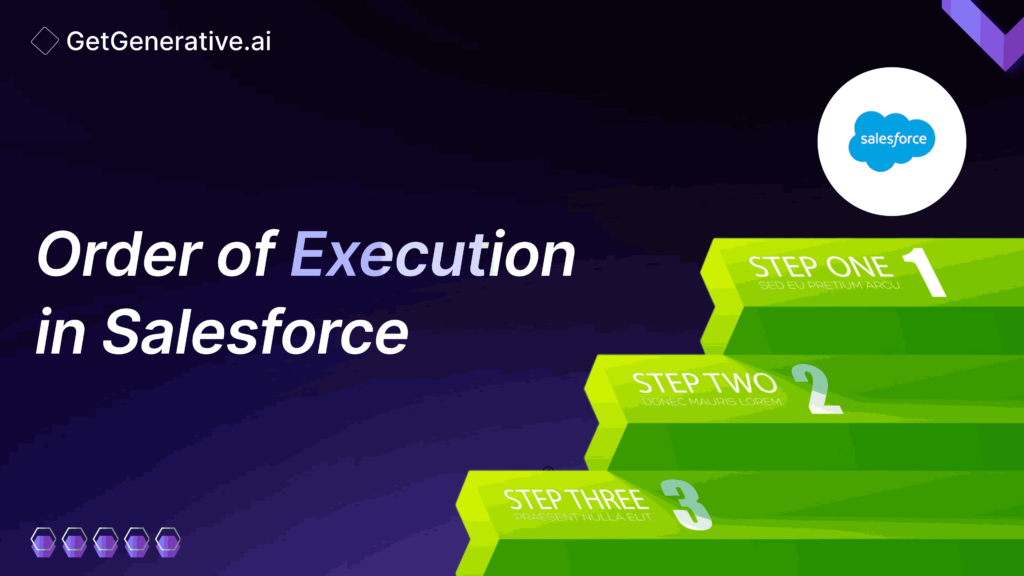Order of Execution in Salesforce
Understanding the order of execution is crucial for building efficient and bug-free applications in Salesforce development.
According to survey results, over a quarter of developers (27%) identified managing longstanding technical debt as the primary obstacle in Salesforce development. Additionally, one-fifth of respondents (20%) reported difficulty determining project requirements.
What is the order of execution in Salesforce?
The execution order in Salesforce refers to the sequence in which various automations, validations, and custom logic are processed when a record is saved. This sequence is deterministic and follows a specific pattern, ensuring consistent behavior across the platform.
How does the Salesforce process trigger?
Salesforce processes triggers as part of the overall order of execution. Triggers are executed at specific points during the save process before triggers fire before the record is saved to the database and after triggers firing after the record has been saved.
Detailed steps in Salesforce execution order
- System validation rules
- Before triggers
- Custom validation rules
- Duplicate rules
- Record-triggered flows (before saving)
- Record save
- After triggers
- Assignment rules
- Auto-response rules
- Workflow rules
- Processes and flows
- Escalation rules
- Roll-up summary fields
- Sharing rules
- Record-triggered flows (after save)
- Criteria-based sharing recalculation
Salesforce trigger processing sequence
Understanding the trigger processing sequence for Service Cloud Consultants is crucial for optimizing case management and customer service processes. Let’s break down the sequence in detail:
Before Triggers:
- Executed first in the order of execution
- Types: before insert, before update, before delete
- Use cases:
- Populating default case values before insertion
- Updating related records before the main record is saved
- Performing complex validation logic
System Validation and Custom Validation Rules:
- Executed immediately after before triggers
- Ensures data integrity and business rule compliance
- Service Cloud example: Validating that a case has all required fields before escalation
Record Save (not committed):
- The record is saved to the database but not yet committed
- This allows for potential rollbacks if subsequent steps fail
After Triggers:
- Executed after the record is saved but before the commit
- Types: after insert, after update, after delete, after undelete
- Use cases:
- Updating related records based on the new/changed case data
- Initiating asynchronous processes like sending emails or creating tasks
- Calculating SLA timers or updating case metrics
Assignment Rules, Auto-response Rules, Workflow Rules, and Processes:
- Execute after triggers but before the final commit
- Critical for automating Service Cloud processes:
- Assignment rules route cases to appropriate queues or agents
- Auto-response rules send initial customer communications
- Workflow rules update related records or send notifications
- Process Builder processes can execute more complex multi-object automations
Record Commit:
- The transaction is finalized, and changes are committed to the database
Key Considerations for Service Cloud Consultants:
- Triggers should be designed to handle bulk operations efficiently
- Avoid recursive trigger scenarios that can impact performance
- Utilize trigger handlers and a robust trigger framework for maintainability
- Consider the implications of triggers on assignment rules and workflows
- Use platform events for scenarios requiring custom execution sequences
- Implement queueable Apex for long-running operations that could timeout in a synchronous context
Also Read – Salesforce Service Cloud Implementation Guide
How to debug triggers in Salesforce?
Debugging triggers in Salesforce requires a methodical approach:
- Use System.debug() statements strategically within your trigger code
- Leverage the Developer Console’s debug logs to trace execution
- Implement a trigger framework that allows for easy debugging and maintenance
- Utilize Apex Replay Debugger for step-by-step execution analysis
- Implement a custom logging system for complex scenarios
For Service Cloud implementations, focus on debugging scenarios that involve multiple objects and complex customer service processes.
Best practices for configuring workflow rules
When configuring workflow rules for Service Cloud:
- Prioritize time-dependent workflows for SLA management
- Use field updates judiciously to avoid recursive triggers
- Implement workflow rules for automated case routing and escalation
- Leverage cross-object workflow rules for holistic customer service processes
- Always consider the order of execution when designing workflow rules
Why is understanding the order of execution important?
For Service Cloud Consultants, understanding the order of execution is critical because:
- It helps in designing efficient case management processes
- It allows for accurate SLA calculations and enforcement
- It ensures proper data consistency across related objects (e.g., Cases, Contacts, Accounts)
- It helps in troubleshooting complex automations and identifying performance bottlenecks
- It enables the creation of scalable and maintainable Service Cloud solutions
Is the execution order configurable in Salesforce?
No, the execution order in Salesforce is not configurable. It follows a predetermined sequence to ensure consistency across all orgs. However, Service Cloud Consultants can leverage this fixed order to their advantage by:
- Designing automations that work harmoniously with the execution order
- Using platform events for scenarios that require custom execution sequences
- Implementing queueable Apex for operations that need to occur outside the standard order
- Utilizing async operations for long-running processes that might impact performance
Conclusion
Mastering the execution order in Salesforce is crucial for Service Cloud Consultants. It enables the creation of robust, efficient, and scalable customer service solutions. By understanding this fundamental concept, consultants can optimize automations, improve system performance, and deliver exceptional service experiences.
Enhance your Salesforce consulting with GetGenerative.ai. Effortlessly craft outstanding proposals, enabling you to dedicate more time to providing exceptional client service.
Start today!
Frequently Asked Questions (FAQs)
1. How does the order of execution impact Service Cloud performance?
It affects the speed of case processing, SLA calculations, and overall system responsiveness.
2. Can triggers interfere with workflow rules in Service Cloud?
Yes, improperly designed triggers can cause conflicts with workflow rules, especially in complex case management scenarios.
3. How do record-triggered flows fit into the order of execution?
Record-triggered flows execute at specific points in the order of execution, before or after the record is saved to the database.
4. What’s the best way to handle complex logic that spans multiple objects in Service Cloud?
Utilize a combination of triggers, flows, and queueable Apex to distribute processing and maintain performance.
5. How can I ensure my Service Cloud customizations adhere to best practices regarding the order of execution?
Regularly review and refactor your automations, use debugging tools, and consider implementing a trigger framework for better control and maintainability.




